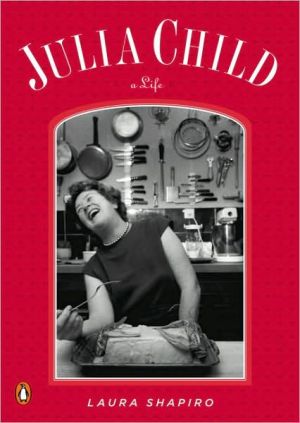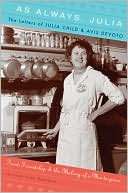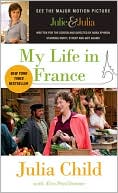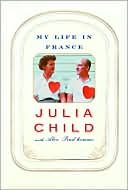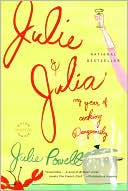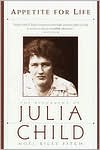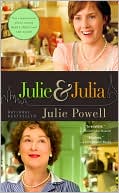Julia Child
With a swooping voice, an irrepressible sense of humor, and a passion for good food, Julia Child ushered in the nation’s culinary renaissance. In Julia Child, award-winning food writer Laura Shapiro tells the story of Child’s unlikely career path, from California party girl to coolheaded chief clerk in a World War II spy station to bewildered amateur cook and finally to the Cordon Bleu in Paris, the school that inspired her calling. A food lover who was quintessentially American, right down...
Search in google:
The delicious life of one of the most beloved figures in twentiethcentury American culture-soon to be played by Meryl Streep in a major motion pictureWith a swooping voice, an irrepressible sense of humor, and a passion for good food, Julia Child ushered in the nation's culinary renaissance. In Julia Child, award-winning food writer Laura Shapiro tells the story of Child's unlikely career path, from California party girl to coolheaded chief clerk in a World War II spy station to bewildered amateur cook and finally to the Cordon Bleu in Paris, the school that inspired her calling. A food lover who was quintessentially American, right down to her little-known recipe for classic tuna fish casserole, Shapiro's Julia Child personifies her own most famous lesson: that learning how to cook means learning how to live. Entertainment Weekly Laura Shapiro's life of Julia Child packs the oft-told story of the gregarious giantess into 181 taut pages. Raised in a wealthy family, Julia McWilliams chafed at the stuffy pastimes of her social set, joined the OSS, and, while working in Ceylon, met her husband, Paul Child. In 1948 the newlyweds moved to France, where Julia sampled a famously mind-blowing sole meunière - ''handsomely browned and still sputteringly hot under its coating of chopped parsley'' - and found her calling. What followed is legendary: the Cordon Bleu courses, the contentious work on the cookbook Mastering the Art of French Cooking, the popular TV shows. Shapiro digs beneath the familiar milestones, unearthing Child's shortcomings (she once called for the ''de-fagification'' of American cooking) and, more importantly, the source of her phenomenal appeal. People loved Julia because she was exuberant and unpretentious. Because when her tarte tatin collapsed, she patched it up and said, ''I think that actually makes a more interesting dessert.'' Because she licked the spoon, relished U.S. supermarkets, and did not reflexively sneer at McDonald's [indeed, she deemed the fries ''surprisingly good'']. A-
Read an Excerpt\ Soon after Julia and Paul settled in Paris, an old woman told Julia that France was "just one big family." As far as Julia was concerned, that family was hers. At their favorite restaurant, Michaud, she couldn't stop glancing over at a dozen people celebrating around a table spread with "innumerable courses of everything" —champagne, chickens, salads, cheeses, nuts—and everyone relaxed and goodhearted as they talked and ate and drank. "We keep being reminded of the Orient," she wrote home. "Possibly because both are cultivated old civilizations, who enjoy and have integrated the physical and the cultural things in living." Julia was at home here. The French struck her as wonderfully natural and earthy, and at the same time immensely civilized. They seemed to believe that the great pleasures of life—food, drink, sex, civility and conversation, pets, children, the splendor of Paris—were simply part of the fabric of being human, and that to enjoy them was as fundamental as breathing. Yet it was also taken for granted that stewardship of these gifts meant relishing them openly, discussing them, arguing about them, and keeping them meaningful through the very power of appreciation. Here was a whole country dedicated to being "worldly." Right away she started French lessons at Berlitz: nothing was more important to her at this stage than becoming comfortable in the language. She was ecstatically absorbing the city, all her senses wide open and craving more; and she wanted the sounds as well, that constant chatter in the shops and streets; she wanted to "talk and talk and talk" and make a place for herself in the life flowing around her. "Oh, La Vie! I love it more every day."\ They found an apartment at 81, rue de l'Université, on the Left Bank of the Seine across from the place de la Concorde, in an old private house. Their rooms on the third floor were as French as the view of rooftops outside the windows. Sagging leather wallpaper, gilt chairs, moldings, and mirrors everywhere—Julia called it "late 19th century Versailles." Up a narrow flight of stairs there was a roomy kitchen with appliances so small in relation to her height that she might have been standing over a toy stove. She decided she could live right there in that apartment forever, in perfect happiness. Already she regretted missing Paris in the twenties, an era Paul had seen in person; and she pounced happily on the occasional sighting of such figures as Colette, Chanel, André Gide, and Sylvia Beach. Once, when the Childs gave a Bastille Day party, Paul invited Alice B. Toklas, whom he had met back in the twenties. She arrived, drank a glass of wine, and left. Toklas was so tiny, and wore such a wide- brimmed hat, that the only way Julia could see her face was to be sitting down while Toklas stood directly above her.\ Julia spent her first months studying French, walking through the streets with a map and a dictionary, and tasting, tasting, tasting. Everything she bit into was full of exhilarating flavors: the sausages, the tarts and petits fours, the snails, the Brie, "great big juicy pears," and grapes so sweet she nearly swooned. Like most of their French and American friends in Paris, she and Paul had a maid who cooked and cleaned; but after living that way for a few months, they let her go. They hated having to show up on time for meals, and her cooking disappointed them. Julia was embarrassed to serve guests such inadequate dinners—her own could be alarming at times, but when they came off well, she took a great deal of pride in them. "Besides," she wrote home, "it is heart-rending not to go to the markets, those lovely, intimate, delicious, mouth-watering, friendly, fascinating places. How can one know the guts of the city if one doesn't do one's marketing?" So they hired a cleaning woman to come in twice a week, and Julia gladly took charge of the food. At the market, she examined pigs' heads and scrutinized fruits and vegetables, breathed in the smells of the boulangerie, carefully chose a terrine or pâté from the charcuterie, and chatted away with the shopkeepers. In France, food was a sociable enterprise: everyone had something to say about the turnips or the kidneys, and to be able to join that nationwide conversation—in French! —was Julia's bliss.
\ From Barnes & NobleLike other biographies in the Penguin Lives series, Laura Shapiro's Julia Child is relatively brief (208 pages) and combines perceptive analysis with brisk timeline tracking. Shapiro's Child is more than a zany TV kitchen wizard or a brilliant eccentric with a sweet tooth; she is a vibrant though not unflawed woman who in many ways was a feminist before her time.\ \ \ \ \ Dorothy KalinsThe length of Laura Shapiro's text is constrained by the elegantly slim format of the Penguin Lives series, yet this writer shows enormous grace and food savvy. Shapiro thinks hard about why Julia matters…Reading Shapiro reminds us how Julia Child taught us not just how to cook but how to think about food, a quality sorely missing from the work of the glib TV chefs who've followed her. Shapiro is alert to today's overhyped, foodie America, where cooking is fetishized but seldom understood. When she says of Julia, "One of her lasting gifts to the food world was to help make it a place where good minds could settle in for life," you can just picture her own good mind making itself at home.\ —The New York Times\ \ \ Entertainment WeeklyLaura Shapiro's life of Julia Child packs the oft-told story of the gregarious giantess into 181 taut pages. Raised in a wealthy family, Julia McWilliams chafed at the stuffy pastimes of her social set, joined the OSS, and, while working in Ceylon, met her husband, Paul Child. In 1948 the newlyweds moved to France, where Julia sampled a famously mind-blowing sole meunière - ''handsomely browned and still sputteringly hot under its coating of chopped parsley'' - and found her calling. What followed is legendary: the Cordon Bleu courses, the contentious work on the cookbook Mastering the Art of French Cooking, the popular TV shows. Shapiro digs beneath the familiar milestones, unearthing Child's shortcomings (she once called for the ''de-fagification'' of American cooking) and, more importantly, the source of her phenomenal appeal. People loved Julia because she was exuberant and unpretentious. Because when her tarte tatin collapsed, she patched it up and said, ''I think that actually makes a more interesting dessert.'' Because she licked the spoon, relished U.S. supermarkets, and did not reflexively sneer at McDonald's [indeed, she deemed the fries ''surprisingly good'']. A-\ \ \ \ \ Publishers WeeklyShapiro's biography of Julia Child—one of America's most beloved personalities—is a short but comprehensive book, and the newest in the Penguin Lives series. Born Julia McWilliams in Pasadena, Calif., in 1912, Child attended college and worked for the OSS in Asia during WWII, where she met her future husband. After marrying, they moved to Paris, which led her to cooking classes at the Cordon Bleu. Child had an appetite for learning as well as eating, one that soon developed into a desire to pass on the knowledge and skills—the love—she was acquiring. And in her late 30s, she found her calling. With two women who later coauthored her first book, she started her own cooking school; her class notes led to the cookbook, which eventually led to the television show. Her husband provided steady support, and Child learned of the value of trial and error and an ability to laugh at her mistakes. She was also patient: the cookbook was nearly a decade from conception to publication and the television show started equally shakily. In this wonderful short bio, Shapiro doesn't skimp on less-flattering aspects of her subject's life and personality (Child found homosexuality to be "a rude disruption in the natural order of things"). (Apr.)\ Copyright 2007 Reed Business Information\ \ \ \ \ Library JournalThe celebrated cook gets a nod from "Penguin Lives." Copyright 2006 Reed Business Information.\ \ \ \ \ Kirkus ReviewsShapiro (Something from the Oven, 2004) offers a vivid biography of the 20th century's leading gourmand. Food wasn't very important to Julia Child when she was young. She grew up in California, eating the bland New England cuisine that her Massachusetts-born mother instructed the future chef to prepare. After attending Smith College, she meandered through the next decade, single, without a real career. In 1946, in part because she was trying to make herself more attractive to the man she would eventually marry, she took a cooking class. Child was not, Shapiro makes clear, a born chef: In the early days, chickens were blackened to a crisp; a duck exploded; bearnaise sauce congealed; brains dissolved into mush. As a new bride in France, floundering around for something meaningful to do, Child enrolled in more classes, this time at the Cordon Bleu. There, she learned to cook "with all her senses engaged . . . with a visceral understanding of raw ingredients." A career-teaching Americans how to cook-was born. Why was she so successful on TV, in an era when cooking shows weren't very popular? Because, says Shapiro, Child had no artifice. She was herself on television. She was also fabulously composed in the face of on-air kitchen disasters-as when a tarte tartin collapsed in a heap. Her informal charm and humor helped her accomplish one of her central goals-to demystify French cuisine, and convince Americans that they could, to borrow the title of her most famous book, master the art of French cooking. In Shapiro's hands, Child emerges as a steadfast, vigorous, analytical person. Shapiro has, in a brief book, made her subject truly come alive.\ \
